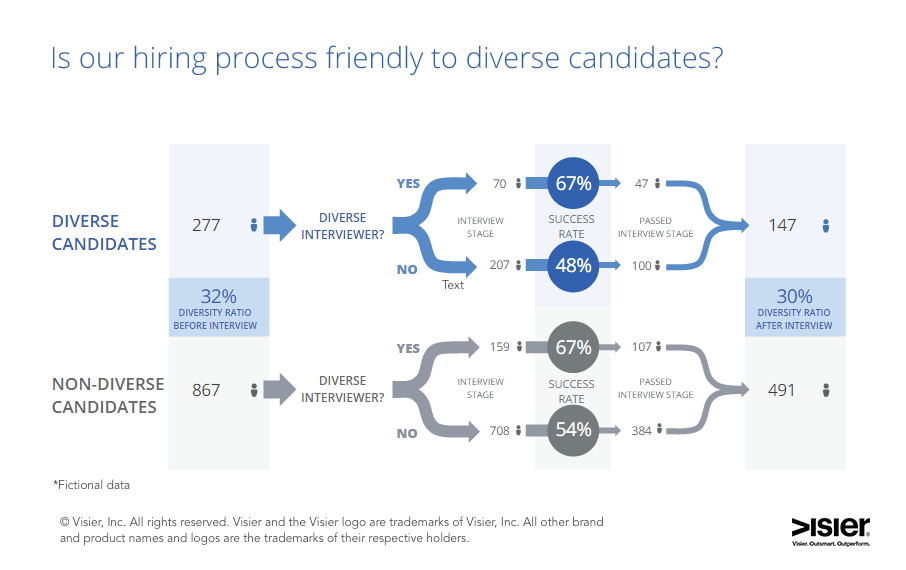How AI Supports More Inclusive Hiring Practices
AI for diversity - AI can be a tool for helping human recruiters overcome implicit bias and include talented workers who would otherwise get left behind.

No, the resume is not dead. Diversity and inclusion efforts may lead to its eventual demise, however.
The traditional process of scanning and tossing out resumes is clearly riddled with implicit bias. According to one intensive academic study, minority applicants who “whitened” their resumes were more than twice as likely to receive calls for interviews, and it did not matter whether the organization claimed to value diversity or not.
Many vendors have touted AI as a way to overcome bias in resume parsing, but there are two problems with this. First, sorting resumes more efficiently is not going to move the needle on diversity and inclusion (D&I) if there aren’t enough people from a variety of backgrounds in the candidate pool.
Second, AI-fuelled resume sorting applications can make existing bias worse. Consider Amazon’s experimental recruiting engine. Having learned from the training data that male candidates had more experience in technical roles, the application started penalizing resumes that included the word “women’s” as in “women’s volleyball.” (Amazon did wisely scrap the project, by the way.)
So not even AI can save the resume, and algorithms are no panacea for D&I. But when the technology is applied within a thoughtful context, it can be a powerful tool to help level the playing field for people who have traditionally been overlooked.
The promise of AI for diversity and inclusion
In the year 2000, Harvard economics and law fellow Michael Rosenbaum shared a new idea with the White House: he argued that underserved urban populations were an untapped source of talent for software development.
The White House dismissed his idea, however, so he went on to found Catalyte. As the company’s CEO Jacob Hsu explains in a Q&A with McKinsey, their business model is based on the fact that people don’t need a certain pedigree to be an exceptional software developer.
“A lot of it really is finding the best people who think a certain way, who have the right aptitude for this work. AI can predict that,” he says.

Data visualization showing whether a company’s hiring process is friendly to diverse candidates
For software development roles at the company, a four-year degree is not required. (In a move to improve diversity, several big tech companies, including Google, Apple and IBM, are no longer requiring applicants to have college degrees.)
Instead of relying on past experience, Catalyte uses its proprietary algorithms (which took more than four years to refine) when assessing new hire potential. After a candidate successfully completes an online assessment and is hired, the company then trains the new hire for five months via an onboarding program. Graduates are guaranteed employment in a two-year apprenticeship program.
By taking human bias out of the candidate selection process and removing the educational requirement, the company has a workforce that reflects the demographics of the region it is hiring from.
“African Americans are 13 percent of the population, and we have exactly 13 percent African American developers. On gender, we’re at 31 percent female developers,” says Rosenbaum.
While Rosenbaum claims that Catalyte is unique in its focus on evaluating potential rather than current skills, it is not the only company to use AI for candidate assessment and boost diversity as a result.
At Unilever, candidates apply for jobs via LinkedIn, and then play neuroscience-based games that measure cognitive and behavioral traits on a platform provided by technology company Pymetrics. The results are analyzed by algorithms that compare an applicant’s skills with those of employees. Since implementing this approach, reports Business Insider, the company has experienced a significant increase in hires of non-white candidates.
This shows that, when AI is applied within a thoughtful context that considers the real barriers to employment, it can be a tool for helping human recruiters overcome implicit bias and include talented workers who would otherwise get left behind.
Maintain–don’t just build–a diverse workforce
AI for candidate assessment is only part of the solution for attracting and maintaining a diverse workforce, however. Ramping up on efforts to increase the representation of certain groups will all be for naught if these individuals are having a poor experience after they join the organization. Many D&I leaders are not in a position to assess this in an objective way.
Only 35% of CDOs are tracking diversity data, according to a recent report delivered by Russell Reynolds. If an organization is not tracking this data, they may be missing important markers that will help determine whether people are being exposed to fair practices. For example, when business leaders understand engagement among diverse employees and monitor the impact engagement has on turnover and exit patterns, companies are in a better position to design interventions that focus on certain groups of people.
This is one example of how sustainable diversity is built on an understanding of the entire employee lifecycle, not just hiring. And when technology is incorporated into traditional disciplines like economics, organizations can build the kind of employment market where all talented people have an opportunity to thrive, regardless of their background
Get Outsmart content straight to your inbox
Subscribe to the People Insights Monthly newsletter for actionable insights and stories.
Subscribe now